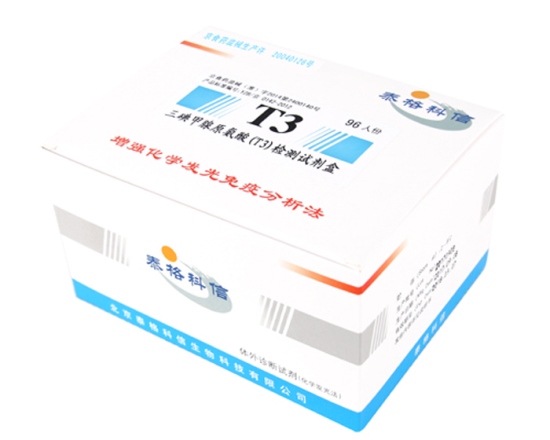

Detection Kit for Triiodothyronine (T3)
(Enhanced chemiluminescence immunoassay)

【Product Name】 Detection Kit for Triiodothyronine (T3) (Enhanced chemiluminescence immunoassay)
【registration certificate number】 京食药监械(准)字2014第2400140号
【Packing】48 tests/box,96 tests/box.
This kit is mainly used for quantitative determination of triiodothyronine (T3) in human serum in vitro.
Hormones secreted by the thyroid include thyroxine (T4) and triiodothyronine (T3). The levels of thyroid hormone in the blood circulatory system often reflect the function of thyroid. Determination of total content of T3 in serum, is important for testing thyroid function and usually as the first choice for the diagnosis of hyperthyroidism, it is also valuable to observe the effect of hyperthyroidism and to judge the prognosis. It is also one of the common reference indexes for the study of hypothalamus-pituitary-thyroid axis function in the diagnosis and treatment of various thyroid diseases.
This kit uses competitive approach. Microplates were coated with purified T3 antibody to make a solid-phase antibody, enzyme labeled T3 antigen and enzyme conjugates are added to the wells coated with the antibody to form a complex called antibody-antigen-enzyme-labeled antigen. enzyme-labeled T3 antigen has inhibited competitive reaction with T3 antigen (standard or test sample); when the reaction achieve a equilibrium, wash away unbound enzyme labeled antigen, The luminescent substrate was added and the luminescence was measured with a photon counter. As the T3 concentration in the sample increases, the luminescence decreases gradually with a linear relationship. Use linear fitting method of log (X) -log (Y) and the instrument software will automatically calculate the T3 content of the sample.
1. Hyperthyroidism:
It is commonly in young women. Clinical manifestations are mainly caused by excessive circulation of thyroid hormone, the symptoms is irritability, insomnia, heart palpitations, fatigue, fear of heat, sweating, weight loss, bulimia, increased stool frequency or diarrhea, menstrual scarce. In physical examination, most patients have varying degrees of goiter, it is diffuse, medium texture and no tenderness. Some patients have exophthalmia.
2. Thyroid inflammation:
① Subacute thyroiditis is often secondary to upper respiratory tract infection, the incidence of spring and autumn are often more. Subacute thyroiditis most occurred in women aged 40-50 years, it is mainly manifested as neck pain, thyroid tenderness on one side, and may appear fever, joint pain and other systemic inflammatory response. Some patients may be hyperthyroidism. Most patients have a severe thyroid gland swelling on one side.
② Chronic lymphocytic thyroiditis, also known as Hashimoto's thyroiditis. It is commonly in women in 30-60 years old. Common symptoms are generalized weakness, most patients have no neck discomfort, but a small number of patients will have partial pressure and neck pain. The thyroid are mostly bilateral symmetry enlargement in examination and isthmus also increased. Tough texture, the surface is more smooth or nodular. A small number of patients may be accompanied by cervical lymph nodes, but soft.
3. Thyroid tumor:
①Thyroid benign tumor is mainly thyroid adenoma. It is mostly occurred in young adults. Clinical manifestations are mostly cervical anterior mass, slow growth and no conscious symptoms. The surface of the physical examination is smooth, soft or tough, the boundary is clear, and can be swallowed up and down. Such as adenoma hemorrhage, mass can be rapidly increased accompanied with local pain, these symptoms can generally disappear within 1-2 weeks.
②Thyroid malignancies with differentiated thyroid cancer are more common in women, it commonly occurs at age of 30-60 years old. Differentiated thyroid cancer develops slowly, the patient can find a painless mass that is gradually increasing in the neck, which has been unintentionally detected by themselves or by a physical examination, or found in B ultrasound examination. Physical examination of cancer more than hard quality, the surface can be smooth, border or clear. If the cancer is limited in the thyroid gland, it can swallow up and down activities; if the cancer is located in trachea or adjacent tissue, it's more fixed.
Clinical laboratory, physical examination center.